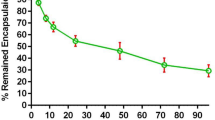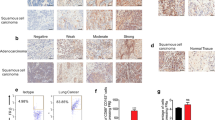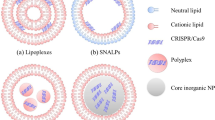Abstract
Lung cancer is one of the leading causes of death in the world. The underlying cause for lung cancer has been attributed to various factors that include alteration and mutation in the tumor suppressor genes. Restoration of normal function of the tumor suppressor gene is a potential therapeutic strategy. Recent studies have identified a group of candidate tumor suppressor genes on human chromosome 3p21.3 that are frequently deleted in human lung and breast cancers. Among the various genes identified in the 3p21.3 region, we tested the antitumor activity of the FUS1 gene in two human non-small-cell lung cancer (NSCLC) xenografts in vivo. Intratumoral administration of FUS1 gene complexed to DOTAP:cholesterol (DOTAP:Chol) liposome into subcutaneous H1299 and A549 lung tumor xenograft resulted in significant (P=.02) inhibition of tumor growth. Furthermore, intravenous injections of DOTAP:Chol–FUS1 complex into mice bearing experimental A549 lung metastasis demonstrated significant (P=.001) decrease in the number of metastatic tumor nodules. Finally, lung tumor-bearing animals when treated with DOTAP:Chol–FUS1 complex demonstrate prolonged survival (median survival time: 80 days, P=.01) compared to control animals. This result demonstrates the potent tumor suppressive activity of the FUS1 gene and is a promising therapeutic agent for treatment of primary and disseminated human lung cancer.
This is a preview of subscription content, access via your institution
Access options
Subscribe to this journal
Receive 12 print issues and online access
$259.00 per year
only $21.58 per issue
Buy this article
- Purchase on Springer Link
- Instant access to full article PDF
Prices may be subject to local taxes which are calculated during checkout





Similar content being viewed by others
References
Carbone DA, Minna JD . In vivo gene therapy of human lung cancer using wild-type p53 delivered by retrovirus. J Natl Cancer Inst. 1994;86:1437–1438.
Hansen HH, Rørth M . Lung cancer. Caner Chemother Biol Response Mod. 1999;18:336–356.
Hoffman PC, Mauer AM, Vokes EE . Lung cancer. Lancet. 2000;355:479–485.
Park BJ, Louie O, Altorki N . Staging and the surgical management of lung cancer. Radiol Clin North Am. 2000;38:545–561.
Bunn PA, Soriano A, Johnson G, Heasley L . New therapeutic strategies for lung cancer: biology and molecular biology come of age. Chest. 2000;117:163S–168S.
Zochbauer-Muller S, Gazdar AF, Minna JD . Molecular pathogenesis of lung cancer. Ann Rev Physiol. 2002;64:681–708.
Gazdar A, Roth JA, Minna JD . Focus on lung cancer. Cancer Cell. 2002;1:49–52.
Wistuba II, Behrens C, Virmani AK, et al. High resolution chromosome 3p allelotyping of human lung cancer and preneoplastic/preinvasive bronchial epithelium reveals multiple, discontinuous sites of 3p allele loss and three regions of frequent breakpoints. Cancer Res. 2000;60:1949–1960.
Girard L, Zochbauer-Muller S, Virmani AK, Gazdar AF, Minna JD . Genome-wide allelotyping of lung cancer identifies new regions of allelic loss, differences between small cell lung cancer and non-small cell lung cancer, and loci clustering. Cancer Res. 2000;60:4894–4906.
Maitra A, Wistuba II, Washington C, et al. High-resolution chromosome 3p allelotyping of breast carcinomas and precursor lesions demonstrates frequent loss of heterozygosity and a discontinuous pattern of allele loss. Am J Pathol. 2001;159:119–130.
Lerman MI, Minna JD . The 630-kb lung cancer homozygous deletion region on human chromosome 3p21.3: identification and evaluation of the resident candidate tumor suppressor genes. Cancer Res. 2000;60:6116–6133.
Sekido Y, Ahmadian M, Wistuba II, et al. Cloning of a breast cancer homozygous deletion junction narrows the region of search for a 3p21.3 tumor suppressor gene. Oncogene. 1998;16:3151–3157.
Kondo M, Ji L, Kamibayashi C, Tomizawa Y, et al. Overexpression of candidate tumor suppressor gene FUS1 isolated from the 3p21.3 homozygous deletion region leads to G1 arrest and growth inhibition of lung cancer cells. Oncogene. 2001;20:6258–6262.
Ji L, Nishizaki M, Gao B, et al. Expression of several genes in the human chromosome 3p21.3 homozygous deletion region by an adenovirus vector results in tumor suppressor activities in vitro and in vivo. Cancer Res. 2002;62:2715–2720.
Uno F, Sasaki I, Nishizaki M, et al. Myristolyation of Fus1 protein is required for tumor suppression in human lung cancer cells. Cancer Res. 2004;64:2969–2976.
Templeton NS, Lasic DD, Frederik PM, et al. Improved DNA:liposome complexes for increased systemic delivery and gene expression. Nat Biotechnol. 1997;15:647–652.
Ramesh R, Saeki T, Templeton NS, et al. Successful treatment of primary and disseminated lung cancers by systemic delivery of tumor suppressor genes using an improved liposome vector. Mol Ther. 2001;3:337–350.
Ito I, Began G, Mohiuddin I, et al. Increased uptake of liposomal–DNA complexes by lung metastases follow-ing intravenous administration. Mol Ther. 2003;7:409–418.
Saeki T, Mhashilkar A, Swanson X, et al. Inhibition of lung cancer growth following adenovirus-mediated mda-7 gene expression in vivo. Oncogene. 2002;21:4558–4566.
Li S, Rizzo MA, Bhattacharya S, Huang L . Characterization of cationic lipid-protamine-DNA (LPD) complexes for intravenous gene delivery. Gene Therapy. 1998;5:930–997.
Tan Y, Li S, Pitt BR, Huang L . The inhibitory role of CpG immunostimulatory motifs in cationic lipid vector mediated transgene expression in vivo. Hum Gene Ther. 1999;10:2153–2161.
Dow SW, Fradkin LG, Liggitt DH, et al. Lipid–DNA complexes induce potent activation of innate immune responses and antitumor activity when administered intravenously. J Immunol. 1999;163:1552–1561.
Ito I, Saeki T, Mohiuddin I, et al. Persistent transgene expression following intravenous administration of a liposomal complex: role of IL-10 mediated immune suppression. Mol Ther. 2004;9:318–327.
Acknowledgements
We thank Nora Rios for assistance in preparation of the manuscript. This work was supported in part by Public Health Service Grant P01 CA78778-01A1 (JAR), by the Specialized Program of Research Excellence (SPORE) in Lung Cancer 2P50-CA70970-04 (JDM and JAR); by a Career Development Award P50-CA70907-5 (RR); by gifts to the Division of Surgery, from Tenneco and Exxon for the Core Laboratory Facility; by the UT MD Anderson Cancer Center Support Core Grant CA 16672; by the Texas Tobacco Settlement Fund as appropriated by the Texas State Legislature (Project 8), by the MD Anderson WM Keck Center for Cancer Gene Therapy (JR, RR), by Texas Higher Education Coordinating Board ATP/ARP Grant 003657-0078-2001 (RR); by BESCT Lung Cancer Program grant DAMD17-01-1-0689 (LJ, RR); by TARGET Lung Cancer Grant DAMD17-02-1-0706 [LJ, RR]; by Cancer Center Support (CORE) Grant CA 16672; and by a sponsored research agreement with Introgen Therapeutics, Inc.
Author information
Authors and Affiliations
Corresponding author
Rights and permissions
About this article
Cite this article
Ito, I., Ji, L., Tanaka, F. et al. Liposomal vector mediated delivery of the 3p FUS1 gene demonstrates potent antitumor activity against human lung cancer in vivo. Cancer Gene Ther 11, 733–739 (2004). https://doi.org/10.1038/sj.cgt.7700756
Received:
Published:
Issue Date:
DOI: https://doi.org/10.1038/sj.cgt.7700756
Keywords
This article is cited by
-
TUSC2 immunogene enhances efficacy of chemo-immuno combination on KRAS/LKB1 mutant NSCLC in humanized mouse model
Communications Biology (2022)
-
Mitochondrial Fus1/Tusc2 and cellular Ca2+ homeostasis: tumor suppressor, anti-inflammatory and anti-aging implications
Cancer Gene Therapy (2022)
-
Therapeutic delivery of microRNA-143 by cationic lipoplexes for non-small cell lung cancer treatment in vivo
Journal of Cancer Research and Clinical Oncology (2019)
-
TUSC2P suppresses the tumor function of esophageal squamous cell carcinoma by regulating TUSC2 expression and correlates with disease prognosis
BMC Cancer (2018)
-
Folate receptor-targeted nanoparticle delivery of HuR-RNAi suppresses lung cancer cell proliferation and migration
Journal of Nanobiotechnology (2016)



